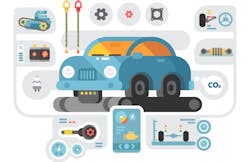In recent columns we’ve been focused on systems and processes that you will find valuable for your damage analysis or blueprinting processes. One of your initial considerations will be whether your blueprinter will also have the role of customer service representative. I don’t recommend having one person perform these dual roles.
Your blueprinter needs to focus on completing all the tasks required to complete a thorough and accurate repair plan and should do this in one continuous flow. If your blueprinter is interrupted by customer drop-offs, check-ins, customer updates, or other random and unscheduled events, the start-stop syndrome will kick in and your blueprinter will struggle to complete the repair plans accurately and in a timely fashion. I think it’s better to have a dedicated customer service representative handle all customer facing events and interactions so that the blueprinter can focus on blueprinting.
So, if you go the route of having a dedicated blueprinter that doesn’t interact with customers, you’ll need a communication system that consolidates the pertinent information gathered from the customer about the damage to their vehicle plus any concerns they might have about the repairs, and delivers this information to the blueprinter. Many shops that have segmented the blueprinting operation have the customer service representative complete a written questionnaire with the customer. This questionnaire should be completed as part of your customer consultation process and should be done by your representative, not by the customer. Once completed, the questionnaire and the vehicle can move to the blueprinting area. You’ll want to develop your own set of questions for your shop but here are some suggestions of what to include relative to what your blueprinter needs to know along with the rationale for asking the question:
How did the damage happen? The answer to this question needs to be as detailed as possible. For example, if the vehicle was hit while parked, the blueprinter will need to know if the vehicle was parked against a curb, which would alert the blueprinter to check for damage to the wheels, tires and suspension on the right side of the vehicle. You’ll want to paint a word picture of what happened in the loss so the blueprinter can visualize the event.
Is everyone OK? Not only do we need to be empathetic with our customers, but if someone was injured in the accident, the blueprinter may also need to look for things like twisted seat-back frames in a rear-end collision, bent steering wheels in a front-end collision, bent gear selectors or center consoles in a side impact. It’s surprising sometimes what secondary damage you find inside the vehicle when a customer tells you about the sore wrist or bruised hip they got from the accident.
How many people were in the car? The answer here can direct the blueprinter to specific inspection areas. As an example, there are many vehicles on the road today that have deployable headrests on the front and rear seats. Some of these headrests deploy and don’t register a DTC or fault on your pre-diagnostic scan/SRS diagnosis because the headrest mechanism is purely mechanical and has no electrical trigger to deploy the headrest.
Was everyone wearing seat belts (locations)? Hopefully everyone buckles up before starting to drive nowadays, but the real reason for asking is so the blueprinter can check for deployed or damaged seat belts. As a side note, more and more OEMs require seat belt inspections after a collision even if they were not in use during the collision
Number of Child Car Seats? Some insurance companies will reimburse the cost of replacing a child restraint that was in use during a car crash. The blueprinter needs to presend this information to the insurance adjuster so that customer can be compensated accordingly.
Have you noticed anything different about the way the car drives? Sometimes a customer might have trouble articulating any changes they notice, but if they say something like, “There’s a rumble underneath when I first start the car” the blueprinter should check the exhaust system for bent pipes or broken hangers. If the customer says, “There’s a loud clunk when I put the car into drive” the blueprinter should look for broken motor mounts. If the car pulls to the right, the blueprinter is going to be inclined to check suspension alignment.
Have you ever had a vehicle repaired at a body shop before? If so, what was good and what was not so good about the repair experience? The answer here will alert the whole staff and the blueprinter to the actions or results that the customer appreciated in the past. You want to replicate the good and avoid the negative experiences.
Is there any additional work, unrelated to this, we can help you with? Does the customer want to pay out of pocket for repair work to be done on the other side of the vehicle? Maybe an upgraded detail or some touch-up paint work? The blueprinter is going to be able to help make sure these things get done, but only if he or she knows about them. I’ve seen customers disappointed when shops did a fantastic job on the major front-end repairs but forgot to touch up the chips on the rear bumper.
Do we need to address any previous repairs or prior related damage? Here, the blueprinter needs to know if the small dent in the middle of a blend panel has been addressed with the customer. Is the customer going to pay for that dent or did the customer decline to repair it? Is the shop going to goodwill the dent repair? What about panels that have poor prior repairs? The blueprinter will need to know what was discussed and agreed to with the customer.
Review the customer’s expectations. Some of the answers here might involve concerns about the use of aftermarket parts, the length of repairs, the cost of repairs, quality levels and options on repair vs. replace of certain parts. Obviously the blueprinter needs to know about these expectations even if they are not always actionable by the blueprinter.
About the Author

Steve Morris
The late Steve Morris was the regional director for Classic Collision in California (formerly Pride Collision Centers). He was an Accredited Automotive Manager (AAM) and ASE-certified master technician. Morris died April 22, 2022, at the age of 63 of complications following surgery.
